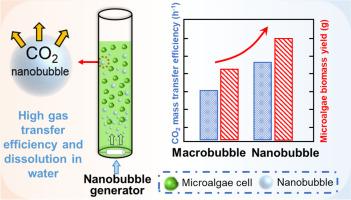纳米气泡和大气泡对水化学、微藻生长和碳利用的影响
IF 12.4
1区 环境科学与生态学
Q1 ENGINEERING, ENVIRONMENTAL
引用次数: 0
摘要
藻类生物技术为同时捕获二氧化碳(CO 2)和产生生物产品提供了一种经济有效的方法。然而,传统的气体输送方法(如宏观和微气泡)存在气液传质效率(KL·a)和CO2利用率低的问题。研究了CO2纳米泡的水性质及其对CO2传质、利用和微藻生长的影响。结果表明,在去离子水中直接注入CO2纳米气泡可在1分钟内实现CO2快速饱和(1.48±0.08 g·L-1)和纳米气泡密度(1.5 × 108粒·mL-1)。相比之下,在溶解CO2浓度相似的情况下,循环模式在20 min后产生更高的纳米气泡浓度(2.6 × 108颗粒·mL-1)。因此,CO2纳米气泡在去水中的体积传质系数(KL·a)达到12.41±3.49 h-1(循环模式)和18.91±7.68 h-1(直接模式),超过了大气泡的体积传质系数(10.18±2.38 h-1)。与大气泡相比,在14 d内使用CO2纳米气泡可使斜地木犀草生物量增加10.11±0.01%,碳利用效率(CUE)达到27.86±0.63%,这主要得益于CO2传质或碳传递效率的提高。这些发现突出了纳米气泡技术在藻类生物技术应用和全球二氧化碳减排方面的潜力。本文章由计算机程序翻译,如有差异,请以英文原文为准。

Comparative Study of CO₂ Nanobubbles and Macrobubbles: Effects on Water Chemistry, Microalgal Growth, and Carbon Utilization
Algal biotechnology presents a cost-effective approach for simultaneous carbon dioxide (CO₂) capture and bioproduct generation. However, conventional gas delivery approaches (e.g., macro and micro-bubbles) suffer from low gas-liquid mass transfer efficiency (KL·a) and CO2 utilization. This study investigated the aqueous properties of CO₂ nanobubbles and impacts on the CO2 mass transfer, utilization, and microalgal growth. Results revealed that direct injection of CO2 nanobubbles in DI water achieved rapid CO2 saturation (1.48 ± 0.08 g·L-1) and nanobubble density (1.5 × 108 particles·mL-1) within 1 minute. By contrast, the circulation mode produced a higher nanobubbles concentration (2.6 × 108 particles·mL-1) after 20 min with a similar dissolved CO2 concentration. Accordingly, the volumetric mass transfer coefficient (KL·a) of CO2 nanobubbles in DI water reached 12.41 ± 3.49 h-1 (circulation mode) and 18.91 ± 7.68 h-1 (direct mode), exceeding that of macrobubbles (10.18 ± 2.38 h-1). Compared to macrobubbles, the use of CO2 nanobubbles in Scenedesmus obliquus cultivation increased biomass by 10.11 ± 0.01% over 14 days and garnered carbon utilization efficiency (CUE) to 27.86 ± 0.63%, supported by the enhanced CO2 mass transfer or carbon transfer efficiency. These findings highlight the potential of nanobubble technology in algal biotechnology applications and global CO2 emission mitigation.
求助全文
通过发布文献求助,成功后即可免费获取论文全文。
去求助
来源期刊

Water Research
环境科学-工程:环境
CiteScore
20.80
自引率
9.40%
发文量
1307
审稿时长
38 days
期刊介绍:
Water Research, along with its open access companion journal Water Research X, serves as a platform for publishing original research papers covering various aspects of the science and technology related to the anthropogenic water cycle, water quality, and its management worldwide. The audience targeted by the journal comprises biologists, chemical engineers, chemists, civil engineers, environmental engineers, limnologists, and microbiologists. The scope of the journal include:
•Treatment processes for water and wastewaters (municipal, agricultural, industrial, and on-site treatment), including resource recovery and residuals management;
•Urban hydrology including sewer systems, stormwater management, and green infrastructure;
•Drinking water treatment and distribution;
•Potable and non-potable water reuse;
•Sanitation, public health, and risk assessment;
•Anaerobic digestion, solid and hazardous waste management, including source characterization and the effects and control of leachates and gaseous emissions;
•Contaminants (chemical, microbial, anthropogenic particles such as nanoparticles or microplastics) and related water quality sensing, monitoring, fate, and assessment;
•Anthropogenic impacts on inland, tidal, coastal and urban waters, focusing on surface and ground waters, and point and non-point sources of pollution;
•Environmental restoration, linked to surface water, groundwater and groundwater remediation;
•Analysis of the interfaces between sediments and water, and between water and atmosphere, focusing specifically on anthropogenic impacts;
•Mathematical modelling, systems analysis, machine learning, and beneficial use of big data related to the anthropogenic water cycle;
•Socio-economic, policy, and regulations studies.
 求助内容:
求助内容: 应助结果提醒方式:
应助结果提醒方式:


